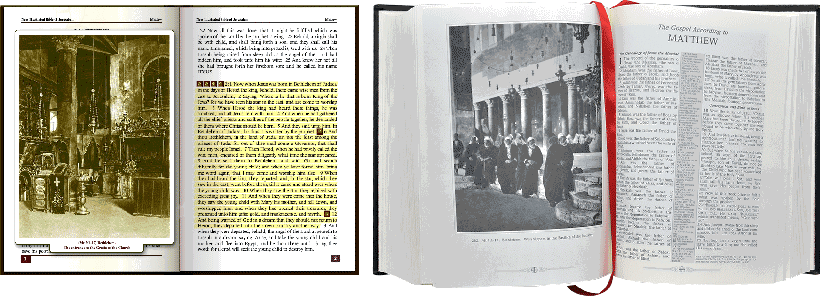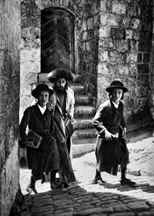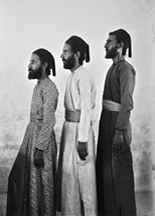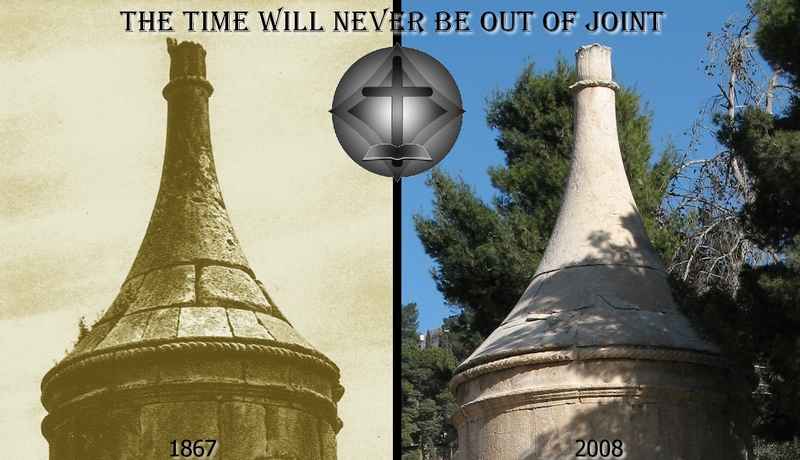Sacralion
visitors
HOME PAGE
Sacralion Publishing House business activity is focused on
the publication of religious literature that covers the historic development of
human society, including the origins and spread of Christianity in the Middle
East.
Visit our new website www.photobibles.com. You’ll find here our new books and much much more.
Our priority is the “History Alive” project. Its first part, "Sacrum Scriptum", is focused on the unprecedented the New Illustrated Bible of Jerusalem (NIBJ), our most important publication (please click here for the further details). As the next step, Publishing House Sacralion is also preparing to publish a 10-volume photo album set “History in Reflections”, which will contain 5,000 photographs of the Middle East, including ancient Babylon, Syria, Mesopotamia, Palestine, Arabia and Alexandria. These 5,000 old black-and-white and modern color pictures of the same scenes and objects, will be placed next to each other to emphasize the development of the modern civilization. The first volume of this set, “ Jerusalem ”, is scheduled for production in the spring of 2010.

We feel
the “History Alive” project will unequivocally
further
serve the development of our
society within the framework of the Christian ethos and help the deeper
recognition of the roles of Jesus Christ and the Holy Bible in modern history.
The Word and the Image
Editorial Foreword
Holy Scripture has become flesh and blood in this world. The bible remains after many years a perennial world best seller. It has been translated into more than 1,800 languages. It has been continuously studied and countless commentaries have been offered on it. However, one odd aspect of this phenomenon is that this book after, accompanying mankind for centuries, still exists as a plain text without a serious well-established tradition of illustration.
Why do the Word and the Image not follow one another hand-in-hand? Does this arise as a result of some ancient ban on depicting the Creator? Perhaps this was true once, but approximately 2,000 years have passed since the one born in Bethlehem lifted this prohibition by bringing down to earth the image of the unimaginable. One may be tempted to think that the river of time has forever washed away the ability to recreate the biblical events and the Holy Text must now remain just a series of words, arousing images only in our imagination.
Many artists (e.g., such as Albrecht Dürer, Gustave Doré, Julius Schnorr von Karolsfeld, et al.) have turned to the
Holy Bible as inspiration. These resulting works, however, always carried the clear imprint of these artists’ personal perceptions and styles.
Even the collective memory
 of peoples and religious communities
of peoples and religious communities
 have been unable
to preserve their historical memory and bring together in a definitive way the
Word and the Image.
Further complicating this issue is the fact that many of the peoples that took part in the Biblical
events, such as Chaldeans, Canaanites, Phoenicians are gone forever. The
People of the Book – the People of Israel – the only surviving successor and
witness to these events, has had its outlook and culture irreversibly
transformed over the millennia, since its
diaspora.
Nonetheless, they also maintain their old ban on the depicting
images.
have been unable
to preserve their historical memory and bring together in a definitive way the
Word and the Image.
Further complicating this issue is the fact that many of the peoples that took part in the Biblical
events, such as Chaldeans, Canaanites, Phoenicians are gone forever. The
People of the Book – the People of Israel – the only surviving successor and
witness to these events, has had its outlook and culture irreversibly
transformed over the millennia, since its
diaspora.
Nonetheless, they also maintain their old ban on the depicting
images.
The worldwide Church has traveled like a ship across the sea of time, and created its own canon of the Image. Primarily, it preserves icons. Of course, peoples’ local habits and cultures have entered this ship, thus leaving their own indelible imprint on this canon. It is only lately, with the advent of the science of archeology, that people have attempted to restore a stricter realism that mirrors biblical places and events.
Besides the biblical texts, the only other witness is the Holy Land itself, where much has remained frozen in time, or at least it did until the end of the 19th century.
Still it would not be completely correct to think that 20th century urbanization erased the last pictures of the Biblical events. Divine Providence has not allowed the chain of witnesses to be entirely broken and has given us tools to help us preserve our visual memory. This witness holds out against our technical civilization that mercilessly consumes our past. This witness is photography, which was invented at the very time immediately before civilization began to encroach upon the Holy Land.
Hebrew, the first language of the Bible, translates “photography” with the term “Tsilum - צילום”, comes from the root “Tselem - צלם”, meaning “Image.” This is what we find at the beginning of the Book of Genesis: “Let us make man in our image, after our likeness”. This is how man, the custodian and the image of creation, was made.
A new edition of the Holy Bible, prepared by Sacralion Publishing House in the course of the Sacrum Scriptum international project, includes 436 pictures as simple and unbiased witnesses of ancient times. Each of these pictures is a history in itself.
These pictures are spread throughout the whole biblical text. They correspond exactly to the places in the text and though not artificially dramatic, they nonetheless manage to evoke a convincing feeling of the presence of biblical history.
Here is a herd of camels drinking from a bowl at only an arm’s distance.
Here is a grove near Hebron, where the patriarchs lived.
Here are the caves near Jerusalem where they buried the prophets.
The shepherds are herding sheep in the same valley where the young, red-haired David did the same before he became King.
Fishermen are fishing on the Sea of Galilee at the same place where once a young rabbi from Nazareth boarded a fishing boat.
We enter this book and it enters us, too. As always, God is revealed to us everywhere where eyes are capable of seeing, hearts are capable of feeling and minds are capable of comprehending.
This new edition of the Holy Bible, known as “The New Illustrated Bible of Jerusalem” (NIBJ), is intended as a reminder to mankind that biblical events do not only belong to the past. History continues and Holy Scripture continues to stir men and history, giving us visible clues of its effects in temples, churches, rituals and ceremonies. It is influencing our lives, spreading out from the Holy Land, the centre of the world, all across the universe. We are all of us both witnesses and participants in this history.
.







